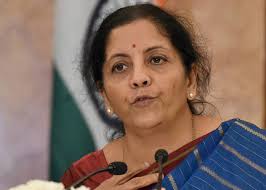 By Nageshwar Patnaik in Bhubaneswar, January 25, 2020: Union Finance Minister Nirmala Sitharaman faces one of the toughest jobs in her career and she has an unenviable task as she present the second budget on February 1. After years of buoyant revenues, she faces the declining growth since she assumed office at North Block in June 2019. Now the moot question is will Sitharaman – who will the first female finance minister and have the distinction of presenting two budgets in less than a year, be able to steer the economy out of one of the most challenging times?
By Nageshwar Patnaik in Bhubaneswar, January 25, 2020: Union Finance Minister Nirmala Sitharaman faces one of the toughest jobs in her career and she has an unenviable task as she present the second budget on February 1. After years of buoyant revenues, she faces the declining growth since she assumed office at North Block in June 2019. Now the moot question is will Sitharaman – who will the first female finance minister and have the distinction of presenting two budgets in less than a year, be able to steer the economy out of one of the most challenging times?
Still worse is the fact that Sitharaman will present the budget in the backdrop of the nationwide din of protests over the Citizenship (Amendment) Act, or the CAA, and the proposed National Register of Citizens (NRC). Hence it will be all the more important for her to make the perfect balancing act. The upcoming budget has to have a vision to make India a globally competitive economy and also spell out a clear roadmap to pull the economy out of the current slowdown.
Expectations from the Modi 2.0 government are high. It would be politically risky to present a Budget that is not influenced by the expectations from key sectors. The ruling BJP had vowed a plethora of promises during the elections, and some of them come with large price tags—at a time when the fiscal deficit is already too high for comfort.
Sitharaman’s first budget last year had set a target of making India a $5 trillion economy by 2024. That target now seems implausible as the Indian economy cannot grow at 8 per cent to achieve this. The current growth rate is half of that — 4.5 per cent in the September quarter and it was 5 per cent in the quarter before that, the CEA and former ISB professor Krishnamurthy Subramanian had said.
 She faces the once familiar challenge of squaring the fiscal circle. Till November, the fiscal deficit stood at 115% whereas the annual target is 3.3%. The hopes are high but unrealistic. Tax revenues are unlikely to grow at a desired level in the fourth quarter with no spectrum auction proceeds, sizeable divestment funds, but the expenses on subsidies, interest payments, salaries consuming a major chunk of revenue are on the rise.
She faces the once familiar challenge of squaring the fiscal circle. Till November, the fiscal deficit stood at 115% whereas the annual target is 3.3%. The hopes are high but unrealistic. Tax revenues are unlikely to grow at a desired level in the fourth quarter with no spectrum auction proceeds, sizeable divestment funds, but the expenses on subsidies, interest payments, salaries consuming a major chunk of revenue are on the rise.
Though the revenue growth remains muted, the corporate tax rate reduction to 22% from 30%, and to 15% from 25% for new manufacturing entities, has only increased the common man’s expectation from the budget. As on November 30, the gap between expenditure and revenue was at ₹8.07 trillion, while the target is at ₹7.03 trillion, with an aim to restrict the deficit at 3.3% of the GDP.
With a persisting slowdown and lack of industrial activity, both GST and direct tax revenues are expected to be below targets. In the July budget, the government had set a highly ambitious tax target despite a shortfall last year. The estimate for gross tax revenue for 2019-20 was revised to Rs 24.6 trillion from Rs 25.5 trillion, announced in the interim budget in February. It was an 18% rise over the tax collected in 2018-19.
The Centre’s gross tax revenues have grown by only 0.81% in the first eight months (April to November) of FY20 and the corporate tax collection has contracted to 0.91% against the targeted 15.4%. It is to be noted that the corporate tax cut shrank the government’s tax revenue for the current fiscal year by Rs 1.45 lakh crore.
 The central GST mop-up at the end of December would stand at Rs 3.72 trillion, against the full-year target of Rs 5.26 trillion. Direct tax collections stood at Rs 5.5 trillion by the end of November, which are a long way off from meeting the budgeted target of Rs 13.35 trillion. This makes it clear that the FM has a Himalayan task before her to come up with a pragmatic Budget. Lower revenue collections will tighten the FM to push-start the economy.
The central GST mop-up at the end of December would stand at Rs 3.72 trillion, against the full-year target of Rs 5.26 trillion. Direct tax collections stood at Rs 5.5 trillion by the end of November, which are a long way off from meeting the budgeted target of Rs 13.35 trillion. This makes it clear that the FM has a Himalayan task before her to come up with a pragmatic Budget. Lower revenue collections will tighten the FM to push-start the economy.
Quite understandably, the Modi government has been emphasizing on disinvestment of state-owned companies to garner revenue. The move is generally a win-win solution as the government gets out of loss-making operations and also earns revenue while doing so. In fact, the Modi government has been setting high disinvestment targets exceeding Rs 50,000 crore each year and has also achieved them in the last two fiscal years. For FY20, the government had set a target of Rs 90,000 crore last February, which was revised upwards to Rs 1.05 lakh crore after it was re-elected – the highest in India’s history. However, the target seems too steep to achieve. So far, the government has managed to raise Rs 17,365 crore through disinvestment; leaving 84 per cent of the target to be realised.
With the Budget day nearing there is a talk of personal and corporate income tax cuts. But these cuts will achieve precious little as it affects barely 3-5 per cent of the adult population. Also, income tax revenues amount to around 2.5 per cent of the GDP and corporate income taxes around 3.3 per cent. Similarly, a tax cut for the rich would be less effective in higher spending. However, an equivalent amount is given to poorer groups; they will spend a much higher fraction of their incomes.
It is needless to say that India is in the midst of a serious economic slowdown. The debates are now mostly about what to do about it: whether to opt for a fiscal expansion to boost demand or to carry out deep reforms to raise productivity and the growth potential of the economy.


Leave a Reply
Be the First to Comment!